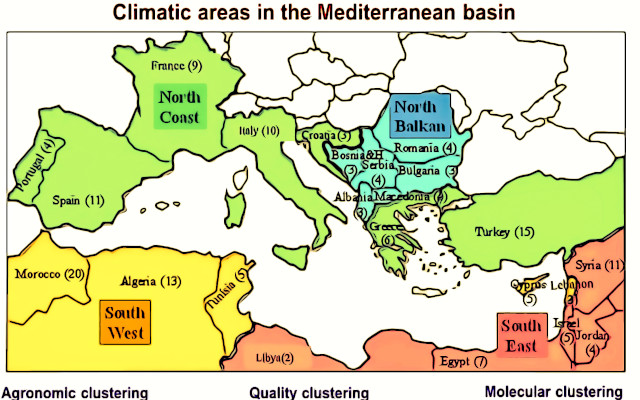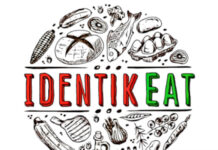The agronomic performance and grain quality of native varieties of common wheat(Triticum aestivum L.), in the Mediterranean, are related to the climates prevailing in their area of origin.
These conclusions are reached in the study (Royo et al., 2022) published in the Journal of Cereal Science by researchers from IRTA(Institute for Food and Agricultural Research and Technology) and the University of Córdoba. (1)
1) Genetic improvement of wheat, from the Neolithic to the modern age.
Genetic improvement of plant species began about 10,000 years ago with the domestication of the first wild plants. Farmers’ cultivation and continuous selection of the best plants has generated an uninterrupted process of genotype modification designed to enable domesticated crops to adapt to agricultural conditions.
Wheat populations, according to tradition, were represented by the so-called landraces. That is, natural populations introduced into agriculture as a result of their significant adaptation to the growing environment. (2) In the past two centuries, however, these landraces have been gradually replaced by cultivars based on single pure lines.
1.1) Modern grains
The increased genetic and phenotypic uniformity of cultivars has allowed for many advantages in carrying out common agricultural practices (e.g., planting, harvesting, combating biotic and abiotic adversities), with increasing use of mechanization.
Modern cultivar selection criteria in the 20th century were also geared toward increasing yields and increasing gluten strength (from <100W to >300W, to shorten time and optimize industrial processing).
The height of the plants was thus drastically reduced (from 150-180 cm to less than 50 cm), in order to concentrate their productive potential in the ears and avoid allurement.
1.2) Ancient grains
Ancient grains-pending an agreed agronomic or legal definition-are understood to be dynamic wheat populations with historical origin, distinct identity, and absence of genetic improvement through inbreeding. Mostly these are locally adapted plants with the help of traditional farming systems (which also still lack unambiguous definition), characterized by taller size and less tenacious gluten than modern varieties.
The traceability of the authentic ancient grain supply chain, in Italy, has been promoted through established the National Register of Conservation Varieties (3,4,5). Through which so-called custodian farmers of can legally market the relevant seeds. And the cultivation of varieties entered in the Register outside the original region of the varieties is prohibited. Just to ensure the continuity of the characteristic link between territories and their evolutionary wheat populations.
1.3) Ancient grains and modern shrewdness.
Strong consumer interest in organically grown ancient grains-in light of their advantages on both the nutritional/health and environmental fronts (6,7)-has led to some shrewdness in recent years:
– cultivation of Timilia (a local Sicilian durum wheat variety) was recorded in Veneto, and even
– a Sicilian variety of durum wheat, Perciasacchi, renamed Khorasan and grown in Puglia, was counterfeited.
1.4) Ancient grains and territories, guarantees and advantages
Legal protection of ancient grains is patchy and ineffective, partly due to staff shortages at public inspection bodies. And that is why this writer recommends that custodian farmers and honest operators ensure the traceability of authentic ancient grains with a public blockchain. (8)
The value associated with the cultivation of ancient grains in the territories where these wheat populations developed, moreover, is not just a legal or marketing issue.
Indeed, the scientific study under review (Royo et al., 2022) demonstrates correlations between the climate of the territories where native wheat varieties have specifically adapted and their main agronomic and quality characteristics. (1)
2) Agronomic performance, soft wheat quality and climate. IRTA’s study
Researchers from Catalonia (IRTA) and Andalusia (Córdoba) analyzed 153 native common wheat varieties collected from 23 Mediterranean countries, identified using 13,177 SNP markers and distinguished by agronomic and quality parameters.
Source regions were classified through analysis of long-term climate data, which showed significant differences between countries located on the northern side and those located on the southern side of the Mediterranean Sea.
2.1) Mediterranean, North and South. The trial
Köppen’s climate classification identified four regions in the Mediterranean basin (Southeast, Southwest, North Coast, and North Balkan). Detecting lower temperatures, photoperiod, and evapotranspiration, in the North, with higher rainfall and relative humidity than in the South.
The analysis of correlations between phenotypic manifestations and the climate of the regions of origin was carried out through experimental cultivation of the numerous varieties under study over a two-year period in northeastern Spain (Gimenells, Lleida).
2.2) The results
Species native to northern Mediterranean countries have been found to be better able to adapt to colder temperatures and greater water availability throughout the entire crop cycle than those from southern areas.
Significant differences were recorded in agronomic yield and cycle length of native varieties in relation to climate. Yields of native varieties from the northern regions were similar, with peaks of the northern Balkan varieties outperforming those from SE (+29%) and SW (+10%) by a wide margin.
In contrast, quality traits did not show significant correlations with the climatic region of origin of wheat species.
3) Interim Conclusions.
Assessing the phenotypic diversity of native wheat varieties that evolve from their native territory to distant environments and climates can provide significant information. Also for the purpose of finding resilient wheat varieties and without neglecting the advantages of varietal mixtures, also highlighted in recent studies (2,9).
Biodiversity is confirmed to play an essential role, to be ensured through organic farming, which can, among other things, enable the entire organic supply chain to achieve a negative carbon footprint. (10) And the desirability of growing native varieties in their own territories finds scientific as well as logical confirmation.
Paolo Caruso and Dario Dongo
Notes
(1) Conxita Royo, Jose Miguel Soriano, Rubén Rufo, Carlos Guzmán (2022). Are the agronomic performance and grain quality characteristics of bread wheat Mediterranean landraces related to the climate prevalent in their area of origin? Journal of Cereal Science, Volume 105, 2022, 103478, ISSN 0733-5210.
https://doi.org/10.1016/j.jcs.2022.103478
(2) Paolo Caruso and Dario Dongo. Wheat varietal mixtures, agrobiodiversity and resilience. GIFT(Great Italian Food Trade). 17.11.19, https://www.greatitalianfoodtrade.it/progresso/miscugli-varietali-di-frumento-agrobiodiversità-e-resilienza
(3) Dario Dongo, Paolo Caruso. Ancient grains, identity and certification. GIFT(Great Italian Food Trade). 4.6.19, https://www.greatitalianfoodtrade.it/certificazioni/grani-antichi-identità-e-certificazioni
(4) Dario Dongo, Paolo Caruso. Genetic characterization of ancient Sicilian grains, a scientific study. GIFT(Great Italian Food Trade). 10.10.19, https://www.greatitalianfoodtrade.it/progresso/caratterizzazione-genetica-dei-grani-antichi-siciliani-studio-scientifico
(5) Dario Dongo, Paolo Caruso. Ancient grains, an innovative method of analysis to verify identity and origin. GIFT(Great Italian Food Trade). 4/28/21, https://www.greatitalianfoodtrade.it/innovazione/grani-antichi-un-metodo-innovativo-di-analisi-per-verificare-identità-e-origine
(6) Dario Dongo, Paolo Caruso. Ancient grains vs modern grains and health, scientific review. GIFT (Great Italian Food Trade).
26.1.20, https://www.greatitalianfoodtrade.it/salute/grani-antichi-vs-grani-moderni-e-salute-rassegna-scientifica
(7) Dario Dongo, Paolo Caruso. Pasta sustainability, ancient and modern grains compared. Scientific study. GIFT (Great Italian Food Trade).
5.11.19, https://www.greatitalianfoodtrade.it/progresso/sostenibilità-della-pasta-grani-antichi-e-moderni-a-confronto-studio-scientifico
(8) Dario Dongo. Public blockchain and agribusiness supply chain, sustainability for producers and consumers. GIFT(Great Italian Food Trade). 28.2.21, https://www.greatitalianfoodtrade.it/progresso/blockchain-pubblica-e-filiera-agroalimentare-sostenibilità-per-chi-produce-e-chi-consuma
(9) Dario Dongo, Paolo Caruso. Biodiversity in agriculture, varietal mixtures of wheat and high quality organic bread. Ecosystems, health and taste. GIFT (Great Italian Food Trade). 11.2.22, https://www.greatitalianfoodtrade.it/salute/biodiversita-in-agricoltura-miscugli-varietali-di-frumento-e-pane-bio-di-alta-qualità-ecosistemi-salute-e-gusto
(10) Paolo Caruso and Dario Dongo. Ancient grains and the fight against climate change, a scientific study. GIFT(Great Italian Food Trade). 4/24/19, https://www.greatitalianfoodtrade.it/progresso/grani-antichi-e-lotta-al-cambiamento-climatico-studio-scientifico









